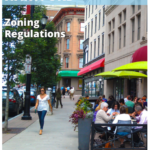Hartford Zoning Code

This code serves as a comprehensive and concise model for citywide form-based standards. The approach to building types creates a rich variety of urbanism and appropriately addresses both the private and public realm. Context-sensitive regulations re-enforce distinct neighborhood character and the elimination of parking requirements reclaims valuable land while improving housing affordability. City staff deserve significant credit for their thorough process of documenting existing conditions and using detailed data analysis as the basis for carefully calibrating the code. Broad community engagement and inclusive partnerships heightened awareness across key institutions and helped reinforce support for code reform. The document is elegantly simple given the complexity of a large city; its organization is commendable and graphics seamlessly guide the reader through applicable standards. The Hartford Zoning Code is politically smart and offers an excellent example of a citywide solution for enhancing diverse neighborhoods while decreasing auto-dependence.
OVERALL CONTEXT
For the first time in 50 years, the zoning regulations of Hartford have been comprehensively revised, resulting in a city-wide form-based code with environmental sustainability at its core.
Once the richest city in the country, Hartford has become a textbook example of the disinvestment of post-industrial America. Struggling with economic decay and high poverty, Hartford retains fifteen charming historic residential neighborhoods, and an increasingly vibrant downtown (with over a thousand housing units in the last few years). Hartford also has a stunning array of natural assets, including the nation’s oldest public park, the largest municipal forest in New England, and the first National Blueway (the Connecticut River).
As far as political context: Over the two-plus year period of code revision, Commission members and staff held over 100 community and stake- holder meetings, including public hearings, interviews, and focus groups. A dedicated website for program updates and feedback was created. A 14-member Zoning Advisory Group weighed in at key points. Given this engagement, the vast majority of the testimony was effusively positive, and the code was passed unanimously by the Planning & Zoning Commission in just one night.
INITIATION
The Planning & Zoning Commission, who has sole authority over Hartford’s zoning code, had long recognized the need for a zoning code that better re-elected the city’s planning goals. But in a struggling city with few resources, external help was needed. The coding revision process was thus intiated in 2013, after the City of Hartford received a grant from the State Department of Transportation. With the grant, the City of Hartford was able to hire a consultant (Codametrics), who worked to document and catalogue the city’s architectural styles, as well as organize and draft the code.
PURPOSE & GOALS
We chose to undertake a comprehensive overhaul for many different reasons. First and foremost, the old code allowed for too many new projects to be built without any recognition of architectural context. For example, one-story drive-thru structures were allowed in some of our most charming historic commercial cores, and McMansions were allowed in our charming residential neighborhoods. In addition, the old code was very unclear, placing too many administrative burdens on applicants and on the City. Finally, the old code failed to promote environ- mental sustainability. Thus our zoning code: strictly regulates form, targets economic growth, and prioritizes environmental sustainability.
UNIQUE ISSUES
Form-based codes are often associated with elite, high-income cities. But Hartford is one of the poorest cities in the country, with some neighborhoods having unemployment rates greater than the rates during the Great Depression and nearly half of children living in poverty. Recognizing these challenges, the zoning code aims to advance economic equity in all that it does. The provision of density bonuses for affordable housing, the allowance of micro-units, and the loosening of the definition of “family” all work together to respond to the economic conditions, within the framework of the form-based code.
MASTER PLAN CONSISTENCY
Hartford’s code fosters built results more consistent with the goals set out in the 2010 “One City One Plan” comprehensive plan, including, among others: protecting neighborhood character, ensuring development more compatible with the historic commercial corridors, and prioritizing environmental sustainability. In addition to ensuring that zoning rules are more compatible with planning goals, the code is one of the clearest codes in the country, having won awards including from the Congress for New Urbanism – New England Chapter.
We think Hartford’s form-based code will be a model for other cities, especially post-industrial cities with struggling economies. The fact that it is comprehensive – covering all neighborhoods and all buildings – is also unusual.
For more information, click here.
Additional Information
Code Categories
Physical Contexts:
Organizing Principles:
Implementation Methods:
Development Types:
Special Features:














